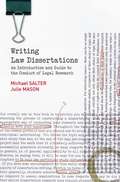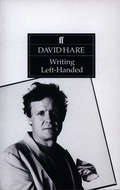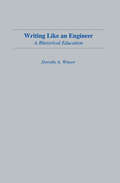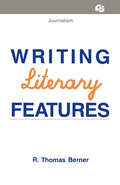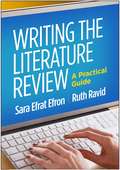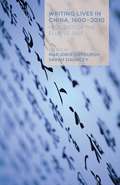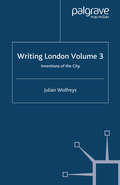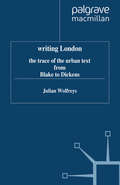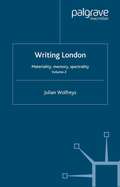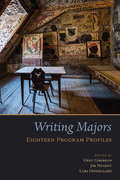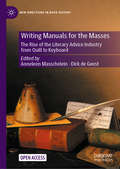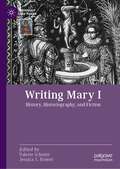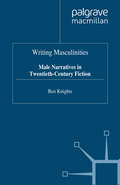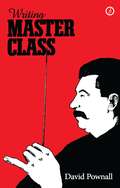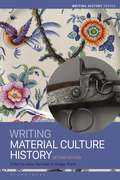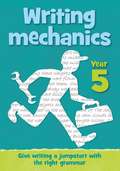- Table View
- List View
Writing Ireland's Working Class: Dublin After O'Casey
by Michael PierseExploring writing of working-class Dublin after Seán O'Casey, this book breaks new ground in Irish Studies, unearthing submerged narratives of class in Irish life. Examining how working-class identity is depicted by authors like Brendan Behan and Roddy Doyle, it discusses how this hidden, urban Ireland has appeared in the country's literature.
Writing Islam from a South Asian Muslim Perspective: Rushdie, Hamid, Aslam, Shamsie
by Madeline ClementsThis book explores whether the post-9/11 novels of Rushdie, Hamid, Aslam and Shamsie can be read as part of an attempt to revise modern ‘knowledge’ of the Islamic world, using globally-distributed English-language literature to reframe Muslims’ potential to connect with others. Focussing on novels including Shalimar the Clown, The Reluctant Fundamentalist, The Wasted Vigil, and Burnt Shadows, the author combines aesthetic, historical, political and spiritual considerations with analyses of the popular discourses and critical discussions surrounding the novels; and scrutinises how the writers have been appropriated as authentic spokespeople by dominant political and cultural forces. Finally, she explores how, as writers of Indian and Pakistani origin, Rushdie, Hamid, Aslam and Shamsie negotiate their identities, and the tensions of being seen to act as Muslim representatives, in relation to the complex international and geopolitical context in which they write.
Writing Jewish: Contemporary British-Jewish Literature
by Ruth GilbertBritish-Jewish writers are increasingly addressing challenging questions about what it means to be both British and Jewish in the twenty-first century. Writing Jewish provides a lively and accessible introduction to the key issues in contemporary British-Jewish fiction, memoirs and journalism, and explores how Jewishness exists alongside a range of other different identities in Britain today. By interrogating myths and stereotypes and looking at themes of remembering and forgetting, belonging and alienation, location and dislocation, Ruth Gilbert examines how these writers identify the particularity of their difference – while acknowledging that this difference is neither fixed nor final, but always open to re-interpretation.
Writing Jewish: Contemporary British-Jewish Literature
by Ruth GilbertBritish-Jewish writers are increasingly addressing challenging questions about what it means to be both British and Jewish in the twenty-first century. Writing Jewish provides a lively and accessible introduction to the key issues in contemporary British-Jewish fiction, memoirs and journalism, and explores how Jewishness exists alongside a range of other different identities in Britain today.By interrogating myths and stereotypes and looking at themes of remembering and forgetting, belonging and alienation, location and dislocation, Ruth Gilbert examines how these writers identify the particularity of their difference – while acknowledging that this difference is neither fixed nor final, but always open to re-interpretation.
Writing Landscape and Setting in the Anthropocene: Britain and Beyond
by Philippa Holloway Craig Jordan-BakerThis edited collection offers an in-depth exploration of the role of landscape and place as literary ‘settings’. It examines the multifaceted relationships between authors, narrators, and characters to their locales, as well as broader considerations of the significance of the representation of landscape in a world deeply affected by human interventions. Consisting of case studies of projects that engage with these questions, as well as research examining the theoretical underpinnings of both creative practices/processes and post-textual analysis of published works, this volume is both multidisciplinary and interdisciplinary in scope. In the context of the climate crisis and a pandemic which has caused us to re-evaluate the significance of landscape and the environment, it responds to the need to engage current trends within the academy and in broader social debate about our relationship to the natural world.
Writing Law Dissertations: An Introduction And Guide To The Conduct Of Legal Research (PDF)
by Julie Mason Michael SalterThis book covers legal dissertation level research, embracing both LL. B. and the specific demands of LL. M. dissertations. Adopting a highly practical approach, this book shows the reader how to research and write a dissertation, covering the various stages - planning, identifying key issues, utilising the appropriate research methods, time management issues, and managing one's supervision. KEY FEATURES * Shows how to avoid common stylistic and substantive pitfalls * Discusses the character and pros and cons of adopting law and policy methods for defining the issues and conducting legal research - including black letter, socio-legal, interpretive, experiential * A running example throughout the text illustrates the various points made in each section and provides continuity
Writing Left-Handed: Collected Essays
by David HareThe leading British writer-director of his generation, David Hare is also one of the most productive. The last two years have seen the outstanding success of two stage plays, The Secret Rapture and Racing Demon, and the release of two films, Paris by Night and Strapless.The pieces collected here, written left-handed, form both a concealed professional autobiography and a lucid commentary on his work.
Writing Life: Early Twentieth-Century Autobiographies of the Artist-Hero (English Association Monographs: English at the Interface #4)
by Mhairi PoolerWriters’ lives are endlessly fascinating for the reading public and literary scholars alike. By examining the self-representation of authors across the schism between Victorianism and Modernism via the First World War, this study offers a new way of evaluating biographical context and experience in the individual creative process at a crucial point in world and literary history. Writing Life explores how and why a select group of early twentieth-century writers, including Edmund Gosse, Henry James, Siegfried Sassoon and Dorothy Richardson, adapted the model of the German Romantic Künstlerroman, or artist narrative, for their autobiographical writing. Instead of (mis)reading these autobiographies as historical documentation, Pooler examines how these authors conduct a Romantic-style conversation about literature through literature as a means of reconfirming the role of the artist in the face of shifting values and the cataclysm of the Great War.
Writing Like An Engineer: A Rhetorical Education (Rhetoric, Knowledge, and Society Series)
by Dorothy A. WinsorComprised of a study spanning over five years, this text looks at four engineering co-op students as they write at work. Since the contributors have a foot in both worlds -- work and school -- the book should appeal to people who are interested in how students learn to write as well as people who are interested in what writing at work is like. Primarily concerned with whether engineers see their writing as rhetorical or persuasive, the study attempts to describe the students' changing understanding of what it is they do when they write. Two features of engineering practice that have particular impact on the extent to which engineers recognize persuasion are identified: * a reverence for data, and * the hierarchical structure of the organizations in which engineering is most commonly done. Both of these features discourage an open recognition of persuasion. Finally, the study shows that the four co-op students learned most of what they knew about writing at work by engaging in situated practice in the workplace, rather than by attending formal classes.
Writing Like An Engineer: A Rhetorical Education (Rhetoric, Knowledge, and Society Series)
by Dorothy A. WinsorComprised of a study spanning over five years, this text looks at four engineering co-op students as they write at work. Since the contributors have a foot in both worlds -- work and school -- the book should appeal to people who are interested in how students learn to write as well as people who are interested in what writing at work is like. Primarily concerned with whether engineers see their writing as rhetorical or persuasive, the study attempts to describe the students' changing understanding of what it is they do when they write. Two features of engineering practice that have particular impact on the extent to which engineers recognize persuasion are identified: * a reverence for data, and * the hierarchical structure of the organizations in which engineering is most commonly done. Both of these features discourage an open recognition of persuasion. Finally, the study shows that the four co-op students learned most of what they knew about writing at work by engaging in situated practice in the workplace, rather than by attending formal classes.
Writing Literary Features
by R. Thomas BernerFirst Published in 1988. Routledge is an imprint of Taylor & Francis, an informa company.
Writing Literary Features
by R. Thomas BernerFirst Published in 1988. Routledge is an imprint of Taylor & Francis, an informa company.
Writing The Literature Review: A Practical Guide
by Sara Efrat Efron Ruth RavidThis accessible text provides a roadmap for producing a high-quality literature review--an integral part of a successful thesis, dissertation, term paper, or grant proposal. Each step of searching for, evaluating, analyzing, and synthesizing prior studies is clearly explained and accompanied by user-friendly suggestions, organizational tips, vignettes, and examples of student work. Also featured are excerpts from peer-reviewed quantitative, qualitative, and mixed methods articles. This is the first book to focus on crafting different types of reviews (systematic, traditional–narrative, or hermeneutic–phenomenological) that reflect the writer's research question, methodological choices, and approaches to knowledge. It describes what all reviews have in common and highlights distinct characteristics of each type. The book includes dos and don'ts for evaluating studies and constructing an argument, and software suggestions for locating, organizing, and arranging sources. Pedagogical Features *Checklists and "To Do" activities that break down key steps to take. *Boxed examples, graphics that organize and visually illustrate key concepts, and summary tables. *Group activities that invite students to further explore and apply the methods discussed in each chapter. *Detailed directions for using four different organizing strategies: synthesis matrix, summary table, mapping, and topic outline. *End-of-chapter summaries and "What's Next" sections. *Assessment matrices for reviewing and refining the completed literature review.
Writing Lives in China, 1600-2010: Histories of the Elusive Self
by Marjorie Dryburgh Sarah DaunceyThis innovative collection explores the life stories of Chinese women and men between the seventeenth and twenty-first centuries. It draws on both biographical and autobiographical narratives and on perspectives taken from life writing theory to ask how lives were lived and written within and against the rules of the auto/biographical game.
Writing London: Volume 3: Inventions of the City
by J. WolfreysThis book stages a series of interventions and inventions of urban space between 1880 and 1930 in key literary texts of the period. Making sharp distinctions between modernity and modernism, the volume reassesses the city as a series of singular sites irreducible to stable identities, concluding with an extended reading of The Waste Land .
Writing London: The Trace of the Urban Text from Blake to Dickens
by J. WolfreysWriting London asks the reader to consider how writers sought to respond to the nature of London. Drawing on literary and architectural theory and psychoanalysis, Julian Wolfreys looks at a variety of nineteenth-century writings to consider various literary modes of productions as responses to the city. Beginning with an introductory survey of the variety of literary representations and responses to the city, Writing London follows the shaping of the urban consciousness from Blake to Dickens, through Shelley, Barbauld, Byron, De Quincey, Engels and Wordsworth. It concludes with an Afterword which, in developing insights into the relationship between writing and the city, questions the heritage industry's reinvention of London, while arguing for a new understanding of the urban spirit.
Writing London: Volume 2: Materiality, Memory, Spectrality
by J. WolfreysFollowing on from Julian Wolfrey's successful Writing London (1998), this second volume extends Wolfrey's original argument that a new urban sensibility in the nineteenth century had been developed which established new ways of writing about and responding to the city. Writing London - Volume 2 explores through a range of readings of twentieth-century films and texts the complex relationship between the experience of the city, the pleasures of the urban text and the solitary nature of these pleasures. The book has a broad focus, in part dictated not only by the transformation of literary production in the twentieth-century, but also by the need to respond to the changes in both urban representation and London itself. Writers discussed include Virginia Woolf, Elizabeth Bowen, Maureen Duffy, Peter Ackroyd, Iain Sinclair and Michael Moorcock. The volume covers texts from the late nineteenth-century to the end of the twentieth, in a critical reading that incorporates the theoretical insights of Walter Benjamin, Guy Debord and Jacques Derrida.
Writing Majors: Eighteen Program Profiles
by Greg Giberson Jim Nugent Lori OstergaardThe writing major is among the most exciting scenes in the evolving American university. Writing Majors is a collection of firsthand descriptions of the origins, growth, and transformations of eighteen different programs. The chapters provide useful administrative insight, benchmark information, and even inspiration for new curricular configurations from a range of institutions. A practical sourcebook for those who are building, revising, or administering their own writing majors , this volume also serves as a historical archive of a particular instance of growth and transformation in American higher education. Revealing bureaucratic, practical, and institutional matters as well as academic ideals and ideologies, each profile includes sections providing a detailed program review and rationale, an implementation narrative, and reflection and prospection about the program. Documenting eighteen stories of writing major programs in various stages of formation, preservation, and reform and exposing the contingencies of their local and material constitution, Writing Majors speaks as much to the “how to” of building writing major programs as to the larger “what,” “why,” and “how” of institutional growth and change.
Writing Manuals for the Masses: The Rise of the Literary Advice Industry from Quill to Keyboard (New Directions in Book History)
by Anneleen Masschelein Dirk De GeestThis open access collection of essays examines the literary advice industry since its emergence in Anglo-American literary culture in the mid-nineteenth century within the context of the professionalization of the literary field and the continued debate on creative writing as art and craft. Often dismissed as commercial and stereotypical by authors and specialists alike, literary advice has nonetheless remained a flourishing business, embodying the unquestioned values of a literary system, but also functioning as a sign of a literary system in transition. Exploring the rise of new online amateur writing cultures in the twenty-first century, this collection of essays considers how literary advice proliferates globally, leading to new forms and genres.
Writing Mary I: History, Historiography, and Fiction (Queenship and Power)
by Valerie Schutte Jessica S. HowerThis book—along with its companion volume Mary I in Writing: Letters, Literature, and Representations—centers on representations of Queen Mary I in writing, broadly construed, and the process of writing that queen into literature and other textual sources. It spans an equally wide chronological and geographical scope, accounting for the years prior to her accession in July 1553 through the centuries that followed her death in November 1558 and for her reach across England, and into Ireland, Spain, Italy, Russia, and Africa. Its intent is to foreground words and language—written, spoken, and acted out—and, by extension, to draw out matters of and conversations about rhetoric, imagery, methodology, source base, genre, narrative, form, and more. Taken together, these volumes find in England’s first crowned queen regnant an incomparable opportunity to ask new questions and seek new answers that deepen our understanding of queenship, the early modern era, and modern popular culture.
Writing Masculinities: Male Narratives in Twentieth-Century Fiction
by Ben KnightsThe great bulk of work on gender in fiction and literature has reflected feminist concerns and focused on women authors. This book attempts to extend the contemporary preoccupation with representations of gender into the terrain of masculinity and male writing. Drawing on work in both the social sciences and humanities, it explores the narrative representation of masculinity in selected twentieth-century fictions ranging from classic texts by Lawrence and Conrad to novels by John Fowles, Graham Swift, David Leavitt and others.
Writing 'Master Class'
by David PownallWriting Master Class is the biography of David Pownall’s play, Master Class (1983), from conception to coming of age. Threaded through the account of the inception and development of the piece are twists of authorial life-story necessary for the telling. Whereas a novel or poem can be kept a secret until it is properly finished, a play has to go out to meet the people early. On the day the script is put into the hands of actors, the soul of the thing passes out of the author’s control. It can be bent, battered, warped – or improved within its being far beyond expectations. As a drama of dictatorship in art and the cleverness needed to evade its worst manifestations, Master Class has been at large for thirty years, produced in twenty countries, in some several times. What has been done to it, how it has fared, is touched upon but the main story in this book is the making of the piece. This is a fascinating insight into the playwright’s craft.
Writing Material Culture History (Writing History)
by Edited byAnne Gerritsen and Giorgio RielloWriting Material Culture History examines the methodologies currently used in the historical study of material culture. Touching on archaeology, anthropology, art history and literary studies, the book provides history students with a fundamental understanding of the relationship between artefacts and historical narratives. The role of museums, the impact of the digital age and the representations of objects in public history are just some of the issues addressed in a book that brings together distinguished scholars from around the world.This new edition includes:* A new wide-ranging introduction highlighting the role of material culture in the modern period and presenting recent contributions to the field.* A more balanced and easy-to-use structure, including 9 methodological chapters and 20 'object in focus' chapters consisting of case studies for classroom discussion.* 5 fresh 'object in focus' chapters showing greater engagement with 20th-century material culture, non-European artefacts (particularly in relation to issues of power, indigenity and repatriation of objects), architecture (with pieces on industrial heritage in Europe and on heritage destruction in China) and the definitions and limits of material culture as a discipline.* Expanded online resources to help students navigate the museums/institutions holding key artefacts.* Historiographical updates and revisions throughout the text.Focusing on the global dimension of material culture and bridging the gap between the early modern and modern periods, Writing Material Culture History is an essential tool for helping students understand the potential of objects to re-cast established historical narratives in new and exciting ways.
Writing Material Culture History (Writing History)
Writing Material Culture History examines the methodologies currently used in the historical study of material culture. Touching on archaeology, anthropology, art history and literary studies, the book provides history students with a fundamental understanding of the relationship between artefacts and historical narratives. The role of museums, the impact of the digital age and the representations of objects in public history are just some of the issues addressed in a book that brings together distinguished scholars from around the world.This new edition includes:* A new wide-ranging introduction highlighting the role of material culture in the modern period and presenting recent contributions to the field.* A more balanced and easy-to-use structure, including 9 methodological chapters and 20 'object in focus' chapters consisting of case studies for classroom discussion.* 5 fresh 'object in focus' chapters showing greater engagement with 20th-century material culture, non-European artefacts (particularly in relation to issues of power, indigenity and repatriation of objects), architecture (with pieces on industrial heritage in Europe and on heritage destruction in China) and the definitions and limits of material culture as a discipline.* Expanded online resources to help students navigate the museums/institutions holding key artefacts.* Historiographical updates and revisions throughout the text.Focusing on the global dimension of material culture and bridging the gap between the early modern and modern periods, Writing Material Culture History is an essential tool for helping students understand the potential of objects to re-cast established historical narratives in new and exciting ways.
Writing Mechanics Year 5 (PDF)
by Shelley WelshTeach children how to use grammatical structures effectively and accurately in their writing. Using carefully selected ‘authentic’ text types that feature specific grammatical features consistently, these resources will help pupils to explore and recognise where and when grammar is used to effectively communicate a text with its intended audience. Each unit focuses on a grammatical feature and begins with a high-quality example text. Through reading the text with pupils, the purpose (e.g. whether it is written to explain, instruct, argue etc.) and its audience (e.g. parents, children, people interested in a specific topic etc.) can be established. The unit then focusses on identifying one or more of the grammatical features that support the purpose and audience of the text. Using creative activities, each unit then provides opportunities to build confidence with the grammatical features. Finally, through modelled and demonstration writing, the resource offers scaffolded writing opportunities for pupils to write their own texts using the grammatical feature.




